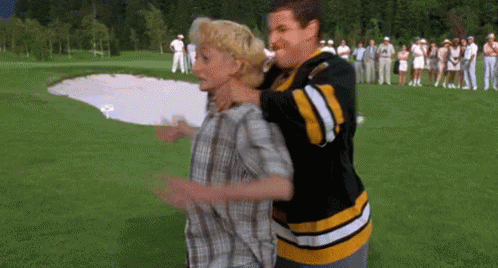The Post-Shot Routine: Learning from Happy Gilmore and Shooter McGavin

Just because you have mastered the art of not-tomahawking-a-golf-club does not mean you have an effective post-shot routine.
Many of the best players in the world have implemented short, consistent post-shot routines to help them process both good and not-so-good shots. Here is your guide to building your own routine.
Why is a post-shot routine important?
Processing a good shot is the fun part of a post-shot routine. After a good shot, you want to build on your positive momentum and mindset. Give yourself a pat on the back for a shot well hit and carry that momentum and mindset to the next shot.
Processing a not-so-good shot is more challenging but more important for your game. You want to determine what impacted the outcome of the shot and make small tweaks accordingly. Try to stay positive and avoid the classic negative spiral. While some small mechanical changes can be made during a round, try to avoid too many mechanical tweaks. Most amateur golfers are better off swinging their swing and then working on their game at the practice facility after the round.
Additionally, the way you process a shot can make it hard for you to find friends to play with too. No one wants to play with the golfer who is wallowing in self pity, yelling at himself, spearing camera men with the pin à la Happy Gilmore, or strangling your caddie.

For the record, Shooter McGavin's post-shot routine is actually pretty good. You can perhaps skip the gestures though and just give your foursome a knowing smile.
Example post-shot routine for you to try
The best post-shot routines are simple and quick. Next time you are on the course, try this post-shot routine out for size. This routine should take all of 10 seconds and get you primed for the next shot.
- Evaluate your result unemotionally.
- Use your evaluation to direct future action in a positive way. Think about what you would have done differently. Make sure it is a positive rather than a negative. For example, if you feel you rushed your pre-shot routine say "Continue to execute your full pre-shot routine" rather than "Do not rush your pre-shot routine".
- Visualize the positive outcome.
- Take a deep breath.
- Move on and focus on the next shot.
Lean on your growth mindset
A player with a growth mindset looks at every shot as a learning opportunity. Try to channel this mindset during your post-shot routine. Every good shot and bad shot gives you a chance to learn and grow as a player.
When you hook it into the woods, think about how it is a good opportunity to test your pre-shot routine and your new playing strategy. When you plug it in the face of a bunker, think about how you will get a chance to play a unique shot and see if the practice you have done from those lies recently at your practice facility is going to pay off.


